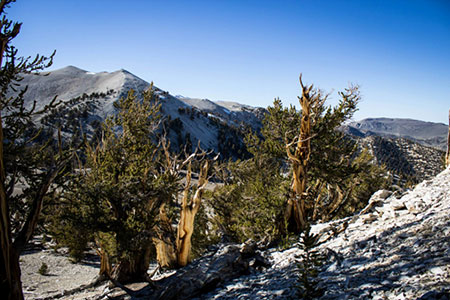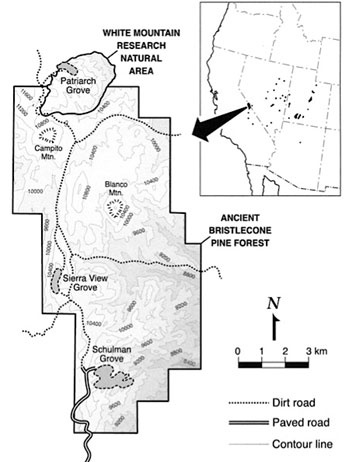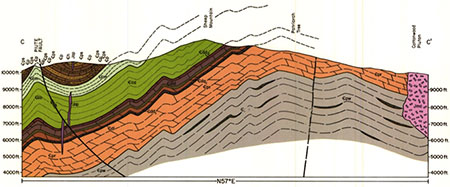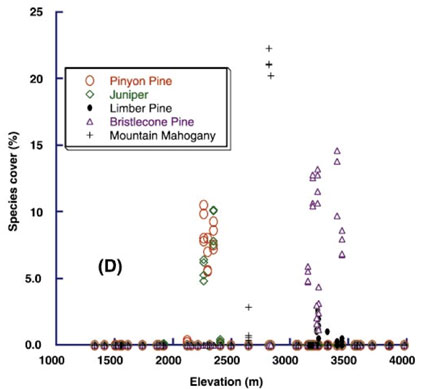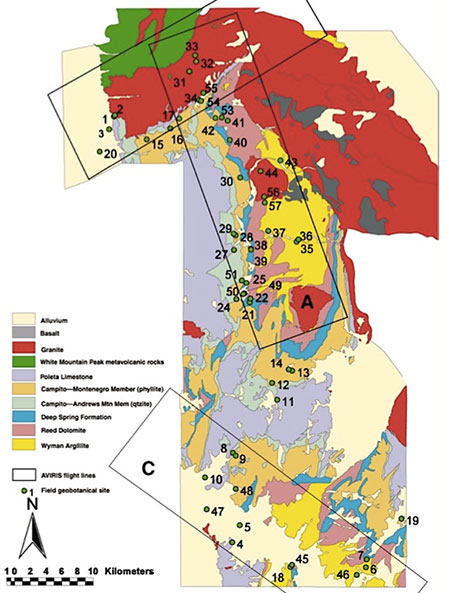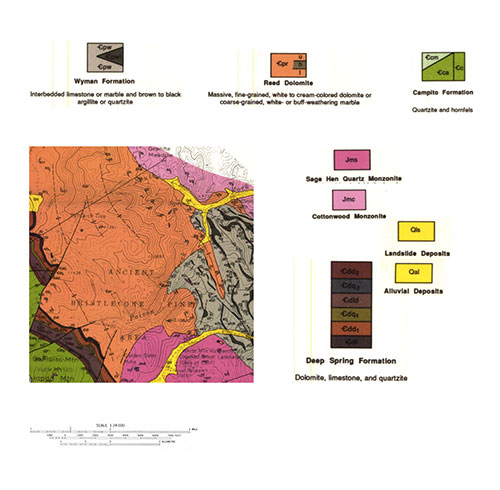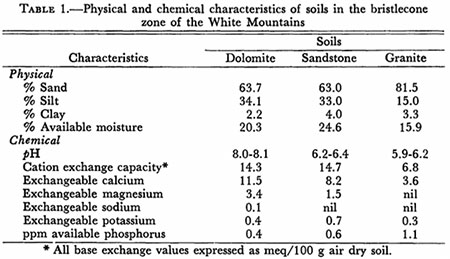Geology and Natural Heritage of the Long Valley Caldera
Living Conditions in Patriarch Grove: The Home Life of Pinus longaeva and the Influence of Soil and other Factors on its Preferred Environment
Kate Griebel
Abstract
Pinus longaeva grow in the White Mountains near Bishop, California. Groves of bristlecone can be found in dolomite–derived soil at elevations between 3100 and 3500 meters. If P. longaeva were alone in the White Mountains, they would populate the other, more nutritious soils. However, P. longaeva currently competes with sagebrush and other plants. To gain access to more sunlight and water, bristlecone have established groves in dolomite, as dolomite soils cannot support other plants, leaving plenty of room for light to reach young bristlecone. In addition, dolomite soils retain more moisture than do other local soils, providing more water to bristlecone roots in times of drought.
Figure 1. Patriarch Grove, looking west from the base of an elevated outcrop. (Photo by Kevin Kuo.)
Introduction
Like many plants, Pinus longaeva grow in a specific climate, at specific elevation, in specific soil. Unlike most plants, individual specimens of P. longaeva have survived in one location for over 5,000 years. These so–called "bristlecone pines& are found in the White Mountains of California, in places like Patriarch Grove and Methuselah Walk. Research regarding the conditions in Patriarch Grove began during or before 1910, with increased attention from 1965 to the present. An examination into the conditions of the area should take into account the parent rock, physiography, and climate of the area. Together, geology, climate, and competition create the bristlecone’s living conditions.
Figure 2. Locations in the White Mountains where bristlecone are known to grow, including the densely populated groves (Lee et al., 2002).
Plants need light, a favorable temperature range, water, access to nutrients, and soil (Cambell et al., 2008). There are other external influences, however, that change the needs of an individual species. Without one of these factors, a certain plant might more densely occupy a slightly different environment. To determine why a plant grows where it does, each factor must be measured and individually analyzed.
Conditions
Geography and Geology
The White–Inyo Mountain Range is located east of the Sierra Nevada Range, southeast of Mono Lake, and west the Nevada state line. It is the eastern edge of the Owens Valley. The Owens Valley depresses to 1225 meters above sea level (Ernst et al., 2003), and the White Mountains reach an elevation of 4343 meters at White Mountain Peak (Ernst et al., 2003). The White–Inyo Range runs north–northwest and is uplifting in the same direction with anticline character (Ernst et al., 2003). Based on geologic maps of the area, the White Mountain surface composition appears to be more complex than that of the nearby Sierra Nevada. The portion of the Sierra Nevada to the west of Patriarch Grove is dominated by exposed granodiorite batholiths; there are only a few other rock types scattered about it (Jennings et al., 2010). In contrast, the White Mountains are composed of many smaller, thinner, more varied units of rock (Jennings et al., 2010).
Physiography, Elevation
The physiography of Patriarch Grove and surrounding areas, in the White Mountains, can be described as mountainous, dominated by slopes, at elevations above 2900 meters and below 3810 meters ("The Old Man" 2002; Ernst et al., 2003; Ernst et al., 1987). Here, more so than in most places, "rapid changes in elevation are associated with abrupt changes in habitats and species" (Hall, 1991). There are rounded peaks and V–shaped valleys, indicating little or no recent widespread glaciation (Wright and Mooney, 1965). The single streams of upper mountain headwaters begin to break into multiple streams; it is here that Wright and Mooney observed slopes facing every direction (1965). The physiography of the land helped Wright and Mooney draw some conclusions about the physical needs of the bristlecone pine– namely, a requirement for open, unshaded areas (1965). They studied the oldest pines, in Methuselah Grove, as well as somewhat younger pines, in Patriarch Grove.
Figure 3. A segment of a geologic map, showing the general SW–NE topography of the Patriarch Grove area. A key with rock types is on page 11. The Patriarch Tree, the widest bristlecone, is located in the right-middle section of this image, solidly within the confines of dolomite (portion of Ernst et al., 1987).
Patriarch Grove is located near 37°32’30" N, 118°12’30" W (decimal form: 37.541667, 118.20833) (Wright and Mooney, 1965) at elevation 3415 meters. To the northwest of Patriarch Grove, Sheep Mountain peaks at 3809 meters (Ernst et al. 1987). Traveling downward and eastward to the Grove, there are slopes of varying orientation and angle, generally about 30–45 degrees, but some angling 50–80 degrees (Ernst et al., 1987). Continuing over a moderately smooth valley to the eastern flank of the Patriarch Grove depression, one sees fewer and sharper slopes than what are on the western flank; the sharper upward angles are of about 50–60 degrees (Ernst, 1987). The high elevation, variety of pressure fronts, and wide valley allow strong winds to blow through the area (National Park Service, 2013; Hall, 1991). These high, dry winds contribute to rapid water loss from plants and ground surface (Hall, 1991).
Bristlecone Characteristics
Bristlecone grow primarily on north and west slopes (Wright and Mooney, 1965). This is possibly in response to rainfall patterns, or to avoid snow and wind damage. Pinus longaeva are widely spaced; set mostly in dolomitic soil; grow short and surprisingly thin for their age; have bottlebrush–like branches of short, thin needles; and in the exposed sections of their trunks, one can see twisted, flowing, densely grown wood grain (Wright and Mooney, 1965; Ernst et al., 2003; and personal observation). Size–wise, most bristlecone are 5–16 meters in height (Encyclopaedia Britannica, 2013). The tallest tree is 18.3 meters tall, and the widest is 11.2 meters in circumference (Miller, 2005). "The trees’ girth increases by just 0.25 millimetres a year" ("The Old Man," 2002). The average age is 1000 years, and the oldest living tree is about 4,600 years old (Miller, 2005; National Park Service, 2013). Their needles can live and photosynthesize for 30 years (Miller, 2005). Where the inner wood of the trees’ trunks is exposed, it is due to the death of energy–wasting, external bark and the wind–driven erosion of the dead bark from the trees’ sides (Miller, 2005; Millar, personal conversation).
Figure 4 shows the percent of land that is covered by various trees at various elevations, in early summer. Percent species cover is ratio of plant-covered area to total area (from Ernst et al., 2003). Bristlecone pine growth is dominant at elevations between 3100 meters and 3500 meters and is absent outside that range.
Climate
The variation in elevations and slope directions in the White–Inyo Mountains creates complex climate patterns (Ernst et al., 2003). Patriarch Grove lies in a "desert mountain range" climate (Wright and Mooney, 1965). Average temperature ranges in the Grove setting are -32°C to 2°C, and average precipitation is between 50 cm at the range’s peaks and 10 cm at its base (Hall, 1991). On average, the Grove is cool, dry, and sunny (Ernst et al., 2003). The combination of cool temperature and low moisture leads to slow chemical weathering (Ernst et al., 2003). This allows wind and plant–driven weathering to take over as primary agents of breaking down rock and dead tree matter (Ernst et al., 2003).
Wright and Mooney reported the presence of relatively weak W/SW winds (1965), which runs contradictory to other claims of strong winds (Hall, 1991; National Park Service, 2013). At any rate, there is some wind, as evidenced by the wind–carried bristlecone seeds and the wind–eroded rock and dead tree matter.
The effect of climate, and climate change, on P. longaeva is dramatic. Plants that grow in very high or very arid areas experience the most reaction to shifts in climate conditions, especially increased temperature (Ernst et al., 2003). Salzer et al. studied tree rings grown over the last few decades, and observed a sustained increase in average width (2009). This "unprecedented" long–term growth of wide rings is thought to be the result of increased temperatures and global, rather than local, climate change (Salzer et al., 2009). Prior to this period of increased growth, the bristlecone survived through the rugged natural conditions of the past few millennia. The dry air restricts the bristlecone water intake, which forces them to consume little and grow slowly, a living style that may have increased their longevity. The dry air does not help the bristlecone expand their girth, but it does prevent dead material from rotting. With the tree’s support structure intact, the still–living wood is held upright and the tree stays alive (Miller, 2005).
The bristlecone can survive through prolonged drought, but to do so requires a storage of resources from other years when water is more plentiful (Ababneh, 2008). Without these stores, the bristlecone would die just like any other water–dependent thing (Ababneh, 2008).
According to Wright and Mooney, bristlecone pine grow in large numbers where the water environment leads them (1965). As is discussed in the soil section, water is likely a determining factor in the bristlecone’s choice of soil.
Figure 5. Simplified regional geologic map of the White–Inyo Mountains (Ernst et al., 2003). Patriarch Grove is near the number 54; the dominant rock of interest is Reed Dolomite (pink).
Bedrock and Substrate
Bedrock and Substrate The parent rock in the bristlecone zone determines whether bristlecone can establish groves (Wright and Mooney, 1965). For the most part, bristlecone restricts itself to dolomite–derived soils. However, individual bristlecone may spring up in other, nearby soils (Wright and Mooney, 1965).
The dominant types of substrate found in the area of study are sandstone, granite, dolomite, and limestone (Ernst et al., 1987 and 2003).
Where Ernst et al. saw an expansive absence of vegetation, they found granitic outcrops (2003). The granite substrate is medium gray, with fine to coarse grains of quartz (Wright and Mooney, 1965).
In areas of sandstone and limestone, there was more vegetation, in some places enough to obscure it from clear view (Ernst et al., 2003). The sandstone and limestone are not clearly differentiated and are complexly associated with other rock types. The material most studied by Wright and Mooney was called sandstone (1965). In the works by Ernst and his groups, the material is most often referred to as limestone. For the sake of this discussion the sandstone/limestone soils are used as a contrast against dolomite and granite, and they will be referred to as sandstone.
The dolomite, where most bristlecone grow, is "massive, medium–grained, and light gray to white" (Wright and Mooney, 1965).
Figure 6. Portion of a geologic map, showing Patriarch Grove, near Mt. Barcroft (Ernst et al., 1987)
Soils
Above and around these substrates are the soils into which they have developed. Soil allows plants to anchor and establish roots, and it provides sustained delivery of nutrients and water (Cambell, 2008). Some soils are more effective at retaining water than others. Some soils have higher nutrient content than others. Most plants near Patriarch Grove exhibit a preference for one or two types of soil over the others (Wright and Mooney, 1965).
The characteristics of soil in the dry White Mountains depend primarily on the substrate material (Ernst et al., 2003). The soils around Patriarch Grove are derived from dolomite, sandstone, and granite (Ernst et al., 1987). There is some material in the area that was carried by wind from the Sierra Nevada (Ernst et al., 2003), but these fragments and the aggregation of dead plant matter have had nominal impact on soil development. The soils have been influenced more by the underlying parent rock than by any other factor, including the direction of their slope face (Wright and Mooney, 1965).
All soils in the area contain relatively low levels of clay, phosphorus, ionic content, and organic matter (Ernst et al., 2003; Wright and Mooney, 1965). The low clay content suggests that organic content and decay of that content was as minimal in the past as it is now. The soils are "shallow, rocky sandy loams" covered almost entirely by small angular rocks ranging from chip–shaped silt to small boulders (Wright and Mooney, 1965; personal obs.).
The differences between dolomitic soils and nearby soils are few but significant. The most visible difference among the soils in Patriarch Grove is their color. Looking upward at a nearby slope, from about 100 meters away, one can see clear lines of separation between lighter surface material and darker surface material. One sees no animal presence and little plant cover. What little life there is divides almost exclusively along the color–lines of the soil. The light dolomitic soil supports widely spaced groves of bristlecone, while the darker granitic and sandstone soils support denser collections of sagebrush and other plants. It is a striking visual aid for distinguishing between the soils.
Nutrition and Sunlight
Dolomite soil is lower in nutrient content than the other soils ("The Old Man" 2002). The dolomite soils are high in calcium and magnesium and have a high pH (Wright and Mooney, 1965). Dolomite soils are so low in nutrition that shallow–rooted plants like sagebrush cannot survive in them (Ernst, 2003). Indeed, in the lab setting, even bristlecone pine grew more strongly in sandstone soil than in dolomite (Wright and Mooney, 1965).
In the natural setting, however, bristlecone are all but absent in sandstone and granite soils. These soils are somewhat acidic and have moderate cation content (Wright and Mooney, 1965). Granite soils are similar to sandstone soils in acidity and cation content, but they hold less water than either sandstone or dolomite soils (Wright and Mooney, 1965). In sandstone soils, sagebrush and other fast–growing, close–growing plants are common (Wright and Mooney, 1965). Shallow–rooted shrubs need the nutrients in sandstone and cannot survive in nutrient–poor dolomite (Wright and Mooney, 1965). In sandstone soils, these shrubs block sunlight from reaching young, sun–thirsty bristlecone; the bristlecone die early, and cannot establish groves in the more nutritious soil (Wright and Mooney, 1965).
Table 1. A summary of soil characteristics of samples taken from the White Mountain, Bristlecone Pine study area, at 3353 m elevation (Wright and Mooney, 1965 [modified]).
Temperature and Moisture
Perhaps most importantly, dolomite soils in Patriarch Grove retain more moisture than do sandstone soils (this is not indicated in Table 1, but it has been supported by numerous reports) (Wright and Mooney, 1965). Dolomite soils are lighter in color, absorb less sunlight, and are usually about 2–3°C cooler, in summer, than other nearby soils, at every measured depth (Wright and Mooney, 1965). The lower temperature allows for improved water retention (Wright and Mooney, 1965).
There are a number of possible explanations for the bristlecone’s natural propensity for dolomite. While the nutrient content does stunt bristlecone growth, it does not stop it. For other plants, the nutrient content is prohibitively low; since bristlecone can grow in dolomite soil, they do so because there is no inter–species competition for the limited resources (Wright and Mooney, 1965). In addition, the lack of plant cover exposes young bristlecone to ample sunlight (Wright and Mooney, 1965). It is also possible, but less supported, that bristlecone crowd out other plants, hogging the scant nutrients in dolomite (Wright and Mooney, 1965).
Hardship and Disease
Since their whole life is hardship, it seems strange to pinpoint any environmental factor that might tip P. longaeva over the edge. They receive very little water and very little nutrition, but too little of either will kill them. They have a very high appetite for sunlight, so much so that they cannot grow in shaded areas. One advantage of the bristlecone location is the rarity of disease, especially insect–borne disease. Disease, insects, and even fungi are rare in the dry, cold, elevated climate of Patriarch Grove (Bidartondo 2001). Bristlecone are resistant to whatever disease might appear there because of their thick, sticky resin and their close–grown, thin, dense rings of wood (Bosman 2011; Miller 2005). They avoid forest fires by spacing themselves far and wide, although the spacing is probably more a mechanism of nutrient limitations than of fire avoidance (Wright and Mooney, 1965). With climate change and the upward migration of insects, bristlecone may face threats unlike those of the past 5000 years (Andersen, 2012).
Conclusion
Bristlecone grow in their particular, characteristic environment. Explanations for why they have chosen this particular habitat are similar, but vary slightly. It is agreed that high elevation is essential to bristlecone growth. A second important factor is competition from other plants that restricts the availability of sunlight and restricts bristlecone to dolomite. Bristlecone can coexist on nutritious soil with small collections of limber pine or sagebrush, but they prefer the solitude of high–elevation, limited–nutrition sites (Bidartondo 2001). Wright and Mooney note that while light is an important resource for the bristlecone, the "moisture gradient" is what decisively controls the pine’s location (1965). Andersen agrees, but continues, "While the low–altitude bristlecones grow in response to rainfall, those near the tree line tailor their growth to temperature" (Andersen, 2012). Temperature plays a decisive role in refining the all-important influence of water. Each factor shapes the other factors’ ability to alter bristlecone growth.
A discussion of Patriarch Grove’s climate, soil types, and associated plant life reveals some of the ancient bristlecone pine’s chemical and physical needs. Their ability to survive where so little else can has enabled them to live there, undisturbed, for over 5000 years. An understanding of the specific environment in which they grow can lead to a better understanding of their remarkable longevity, and of how these beautiful, squat trees survive in such a cold, elevated, nutrient–poor, and apparently life–poor environment. It can lead to a greater understanding of the variation among plants, and the characteristics that allow some species to inhabit even the most inhospitable niches on Earth.
Works Cited
1. Ababneh, L. (2008). Bristlecone pine paleoclimatic model for archeological patterns in the White Mountain of California. Quaternary International. 188(1): pp. 59-78.
2. Andersen, R. (2012). The Vanishing Groves. aeonmagazine.com.
3. Bidartondo, M. I., Baar, J., Bruns, T. D. (2001). Low ectomycorrhizal inoculum potential and diversity from soils in and near ancient forests of bristlecone pine (Pinus longaeva). Canadian Journal of Botany. Vol. 79 Issue 3: pp 293-299.
4. Bosman, J. (2011). Forest of the Ancients. New York Times Magazine. November 13 edition. p 47.
5. Cambell, N. A., Reece, J. B., Urry, L. A., Cain, M. L., Wasserman, S.A., Minorsky, P. V., Jackson, R. B. (2008). Biology, Eighth Edition. San Francisco, CA: Pearson Benjamin Cummings.
6. Encyclopaedia Brittanica. (2013). Bristlecone pine. website.
7. Ernst, W. G., and Hall, C. A. (1987). Geology of the Mount Barcroft–Blanco Mountain area, eastern California (map). Geological Society of America.
8. Ernst, W. G., Van de Ven, C. M., and Lyon, R. J. P. (2003). Relationships among vegetation, climatic zonation, soil, and bedrock in the central White–Inyo Range, eastern California: A ground–based and remote–sensing study. Geological Society of America Bulletin. 115 p. 1583-1597.
9. Hall, C. A. (ed.) (1991). Natural History of the White–Inyo Range: Eastern California. Berkeley: University of California Press.
10. Jennings, C.W., Gutierrez, C., Bryant, W., Saucedo, G., and Wills, C. (2010). Geologic map of California; Geologic Data Map 2. California Geological Survey. website
11. Lee et al. (2002). Genetic Variation in Pinus longaeva.
12. Millar, C. (2013). Lecture and personal conversation at White Mountain Research Center, Bishop, and Schulman Grove, Inyo National Forest.
13. Miller, Leonard. (2005). The Ancient Bristlecone Pine. website
14. National Park Service. (2013). Bristlecone Pines. website
15. Salzer, Matthew W., Hughes, M. K., Bunn, A. G., and Kipfmueller, K. F. (2009). Recent Unprecedented Tree–Ring Growth in Bristlecone Pine at the Highest Elevations and Possible Causes. Proceedings of the National Academy of Sciences of the United States of America. 106(48): pp. 20348-20353.
16. The Old Man. (2002). New Scientist. 176(2365): p 59.
17. Wright, R. D., and Mooney, H. A. (1965). Substrate–oriented Distribution of Bristlecone Pine in the White Mountains of California. The American Midland Naturalist. 73(2): pp. 257-284.
[Return to Research Projects] [Return to Sierra Home]
